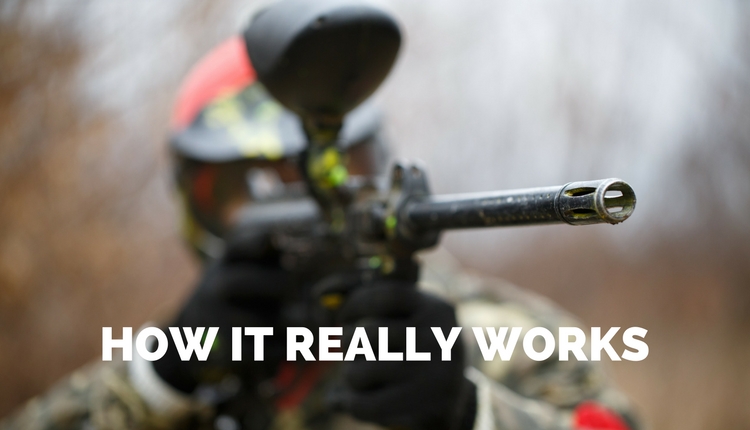We may earn commissions for purchases made through links on our site. Learn more on our about us page.
For a paintballer, there’s nothing worse than getting out in the field and have your gun malfunction. What makes this worse, still, is not knowing how to fix it. If you want to be able to fix the problems your gun may have, then understanding how it works is the first step. We all know that you pull the trigger the paintball goes flying through the air, but what makes that happen? How is the gun able to send the paintball so fast through the air that it can travel the length of a football field or more?
Essential Parts
Though every gun is different, each gun will have specific parts that will remain the same. Ironically, they are mostly the same names used in real firearms. These include:
- Bolt
- Trigger assembly
- Grip
- Slide
- cO2 Cylinder
- Gas lines
Knowing how these parts interact with your particular gun can mean the difference in winning or losing; shooting or getting shot. Study your user manual to discover which parts your weapon has.

Types of Guns
If you are an avid paintballer, then you know there are three main types of paintball guns; spring loaded, gas-fired, and electric. With each different kind, there’s a different method of firing the paintball. Here’s how the three work.
Spring Loaded
his is perhaps the simplest version of the three. However, this is also the least likely to be shot. Reason being is because the paintballs are not able to travel very far. With a spring loaded gun, the shooter pulls back a slide that compresses a spring inside the weapon. Once the slide reaches a certain point, a paintball drops into the barrel in front of the spring. Then, once the shooter is ready, he/she only pulls the trigger. This action releases the compressed spring and sends the paintball soaring through the barrel.
Electric Guns
Some people prefer to have the added benefit of an electronic gun versus a mechanical one. However, both function very similar to each other. The difference with an electronic gun is that the trigger never actually comes in contact with the bolt. Instead, when the shooter pulls the trigger, it releases a relay switch which then tells a solenoid to release air. Once the solenoid releases the air, it pushes the bolt forward sending the paintball through the barrel.
Some people prefer the electronic guns because some of these markers also come with an auto-load feature. With spring-loaded and gas-fired guns, the ball just falls into place with the help of gravity. With an electronic gun, the autoload feature actuals pushes the next ball into place. The reason this is popular is that it allows for less jamming while in rapid fire scenarios. It also allows the shooter to fire more per minute than a gravity-fed gun.
Gas-powered
Gas powered paintballs guns usually use cO2. However, nitrogen is available, though rather expensive. With gas powered guns, there are mainly two setups. The first uses a 16gram cartridge, usually inserted into the grip of the marker. Pistols often use this configuration. The second uses a large cO2 cylinder (available from 38grams and higher) and has a gas line the goes from the cylinder and into the barrel.
Either setup, however, functions the same. The way a gas-powered paintball gun works is when the shooter pulls the trigger, a small burst of compressed gas enters the barrel and fires the paintball out. The balls feed into the barrel by using gravity to drop the ball from the hopper affixed to the top of the gun. Once the barrel slides back into place, another ball drops and another small amount of gas readies in the gas chamber.
Taking it apart
When in the field, it may become necessary to field-strip your gun to correct any malfunctions. This process, however, is easier said than done. Each gun is manufactured different and will have a process designed by the manufacturer for field-stripping. It is best to practice this while at home using the steps outlined in the user’s manual for your particular gun. Repeating this action, slowly at first and then building up speed, will increase your likelihood to fix problems while in combat.
Paintball guns, while not complicated, are finely tuned machines. The incorporation of mechanics with either gas or electronics is astonishing. And, though we rarely think about it while firing at our friends, it’s always good to know just how these guns work.
